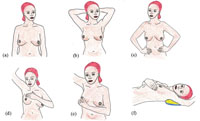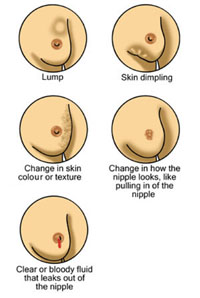
Advise women who find a breast lump to seek medical help – they should not to go to the traditional healers.
Screening refers to any method of examining an apparently healthy person to see if they have the early signs of a particular disease, which would benefit from having early treatment. Screening for breast cancer is easily carried out by women themselves. You should advise women in your community to examine their breasts once every week, using the method of breast self-examination illustrated in Figure 3.3 and described in Box 3.2.

The following steps relate to the diagrams in Figure 3.3 and should be carried out in this order.
If a woman feels an unusual lump or any palpable mass in the breast, or sees a change in the appearance of the breast, she should go to the nearest health centre for further assessment and specialist treatment. The types of changes in the appearance or 'feel' of the breast that should alert a woman to seek medical help are shown in Figure 3.4.

There are also image screening methods for early detection of breast cancer in higher health institutions, using either low-dose X-rays (the technique is called mammography) or ultrasound imaging of the breast. In many high-income countries, all women over the age of 45 or 50 years are screened using these methods every two or three years. However, the technology is not available (or not accessible) in most low-income countries in Africa.